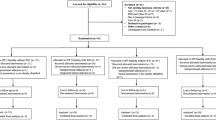Abstract
Background
Little is know about the effects of different insufflation gases on peritoneal pH during laparoscopy. However, these changes may influence the intracellular signalling system, resulting in altered cell growth or adhesiveness. The aim of this study was to determine the effects of carbon dioxide (CO2), nitrous oxide (N2O), and helium (He) on parietal and visceral peritoneal pH. The effect of different intraabdominal pressures on parietal and visceral peritoneal pH was also examined.
Methods
We conducted both an ambient gas study and a pressure study. For the ambient gas study, 20 pigs were divided into the following four groups: (a) CO2, (b) He, (c) N2O, and (d) abdominal wall lift (Lift) laparoscopy. Parietal and visceral peritoneal pH were measured at 15 min intervals for 180 min. For the pressure study, 15 pigs were divided into the following three groups: (a) CO2, (b) He, (c) N2O laparoscopy. Baseline values were established for parietal and visceral peritoneal pH. Intraabdominal pressure was then increased stepwise at 1-mmHg intervals to 15 mmHg. After pressure was maintained for 15 min at each setting, parietal and visceral peritoneal pH were measured.
Results
Ambient gas environment was the major determinant of parietal peritoneal pH. Carbon dioxide caused parietal peritoneal acidosis. Helium, N2O, and Lift caused alkalotic parietal peritoneal pH. Intraabdominal pressure had a minor effect on parietal peritoneal pH. At higher intraabdominal pressure (12–15 vs 5–8 mmHg), CO2 caused a slight decrease in parietal peritoneal pH, whereas N2O and He caused a slight increase in parietal peritoneal pH. Visceral peritoneal pH remained relatively unaffected during all studies.
Conclusions
Parietal peritoneal pH during laparoscopy was highly dependent on the ambient gas environment. The effect of intraabdominal pressure on parietal peritoneal pH was of minor significance. Carbon dioxide caused a slight worsening of parietal peritoneal acidosis at higher intraabdominal pressure, whereas, N2O, He, and Lift did not cause parietal peritoneal acidosis.




Similar content being viewed by others
References
SM Brundell C Tsopelas B Chatterton J Touloumtzoglou PJ Hewett (2002) ArticleTitleExperimental study of peritoneal blood flow and insufflation pressure during laparoscopy Br J Surg 89 617–622
RC Buck (1973) ArticleTitleWalker 256 tumor implantation in normal and injured peritoneum studied by electron microscopy, scanning electron microscopy, and autoradiography Cancer Res 33 3181–3188 Occurrence Handle1:STN:280:CSuD2cfnslM%3D Occurrence Handle4760534
RY Fleming TB Dougherty BW Feig (1997) ArticleTitleThe safety of helium for abdominal insufflation Surg Endosc 11 230–234 Occurrence Handle10.1007/s004649900332 Occurrence Handle1:STN:280:ByiB3snnt1I%3D Occurrence Handle9079598
L Griffiths GU Dachs R Bicknell AL Hanis IJ Stratford (1997) ArticleTitleThe influence of oxygen tension and pH on the expression of platelet-derived endothelial cell growth factor/thymidine phosphorylase in human breast tumor cells grown in vitro and in vivo Cancer Res 57 570–572 Occurrence Handle1:CAS:528:DyaK2sXht1OktLo%3D Occurrence Handle9044826
CN Gutt ZG Kim D Hollander T Bruttel M Lorenz (2001) ArticleTitleCO2 environment influences the growth of cultured human cancer cells dependent on insufflation pressure Surg Endosc 15 314–318 Occurrence Handle10.1007/s004640000321 Occurrence Handle1:STN:280:DC%2BD38%2FgvFyitw%3D%3D Occurrence Handle11344436
JG Hunter J Staheli M Oddsdottir T Trus (1995) ArticleTitleNitrous oxide pneumoperitoneum revisited: is there a risk of combustion? Surg Endosc 9 501–504 Occurrence Handle1:STN:280:ByqH3cnotFc%3D Occurrence Handle7676370
CA Jacobi R Sabat B Bohm HU Zieren HD Volk JM Muller (1997) ArticleTitlePneumoperitoneum with carbon dioxide stimulates growth of malignant colonic cells Surgery 121 72–78 Occurrence Handle10.1016/S0039-6060(97)90185-9 Occurrence Handle1:STN:280:ByiC2MvosVQ%3D Occurrence Handle9001554
TJ Knolmayer MW Bowyer JC Egan HJ Asbun (1998) ArticleTitleThe effects of pneumoperitoneum on gastric blood flow and traditional hemodynamic measurements Surg Endosc 12 115–118 Occurrence Handle10.1007/s004649900609 Occurrence Handle1:STN:280:DyaK1c7ktVemsg%3D%3D Occurrence Handle9479723
CC Nduka M Puttick P Coates L Yong D Peck A Darzi (2002) ArticleTitleIntraperitoneal hypothermia during surgery enhances postoperative tumor growth Surg Endosc 16 611–615 Occurrence Handle10.1007/s00464-001-9055-0 Occurrence Handle1:STN:280:DC%2BD383jsVertg%3D%3D Occurrence Handle11972199
TJ Neuberger CH Andrus CM Wittgen TP Wade DL Kaminski (1996) ArticleTitleProspective comparison of helium versus carbon dioxide pneumoperitoneum Gastrointest Endosc 43 38–41 Occurrence Handle1:STN:280:ByiD2MbkvFE%3D Occurrence Handle8903816
SJ Neuhaus DI Watson (2004) ArticleTitlePneumoperitoneum and peritoneal surface changes: a review Surg Endosc . .
GG Neuman G Sidebotham E Negoianu J Bernstein AF Kopman RG Hicks ST West et al. (1993) ArticleTitleLaparoscopy explosion hazards with nitrous oxide Anesthesiology 78 875–879 Occurrence Handle1:STN:280:ByyB2Mnjt1w%3D Occurrence Handle8489060
MW Roberts KA Mathiesen HS Ho BM Wolfe (1997) ArticleTitleCardiopulmonary responses to intravenous infusion of soluble and relatively insoluble gases Surg Endosc 11 341–346 Occurrence Handle10.1007/s004649900359 Occurrence Handle1:STN:280:ByiB2M%2FntVE%3D Occurrence Handle9094273
B Rudston-Brown PN Draper B Warriner KR Walley PT Phang (1997) ArticleTitleVenous gas embolism—a comparison of carbon dioxide and helium in pigs Can J Anaesth 44 1102–1107 Occurrence Handle1:STN:280:DyaK1c%2FhtFCmtA%3D%3D Occurrence Handle9350372
D Shweild A Itin D Soffer E Keshet (1992) ArticleTitleVascular endothelial growth factor induced by hypoxia may mediate hypoxia-initiated angiogenesis Nature 359 843–845 Occurrence Handle10.1038/359843a0 Occurrence Handle1279431
P Taura A Lopez AM Lacy T Anglada J Beltran L Fernandez-Cruz E Targarona et al. (1998) ArticleTitleProlonged pneumoperitoneum at 15 mmHg causes lactic acidosis Surg Endosc 12 198–201 Occurrence Handle10.1007/s004649900633 Occurrence Handle1:STN:280:DyaK1c7mvFGltg%3D%3D Occurrence Handle9502694
J Volz S Koster Z Spacek N Paweletz (1999) ArticleTitleCharacteristic alterations of the peritoneum after carbon dioxide pneumoperitoneum Surg Endosc 13 611–614 Occurrence Handle10.1007/s004649901052 Occurrence Handle1:STN:280:DyaK1M3nvVGnug%3D%3D Occurrence Handle10347302
P Wildbrett A Oh D Naundorf T Volk CA Jacobi (2003) ArticleTitleImpact of laparoscopic gases on peritoneal microenvironment and essential parameters of cell function Surg Endosc 17 78–82 Occurrence Handle10.1007/s00464-002-9015-3 Occurrence Handle1:STN:280:DC%2BD3s%2FmtFKjuw%3D%3D Occurrence Handle12360379
JS Wolf SuffixJr S Carrier ML Stoller (1994) ArticleTitleGas embolism: helium is more lethal than carbon dioxide J Laparoendosc Surg 4 173–177 Occurrence Handle7919504
YT Wong PC Shah DH Birkett DM Brams (2004) ArticleTitleCarbon dioxide pneumoperitoneum causes severe peritoneal acidosis unaltered by heating, humidification, or bicarbonate in a porcine model Surg Endosc . .
Author information
Authors and Affiliations
Corresponding author
Rights and permissions
About this article
Cite this article
Wong, Y.T., Shah, P.C., Birkett, D.H. et al. Peritoneal pH during laparoscopy is dependent on ambient gas environment: helium and nitrous oxide do not cause peritoneal acidosis. Surg Endosc 19, 60–64 (2005). https://doi.org/10.1007/s00464-003-9291-6
Received:
Accepted:
Published:
Issue Date:
DOI: https://doi.org/10.1007/s00464-003-9291-6




